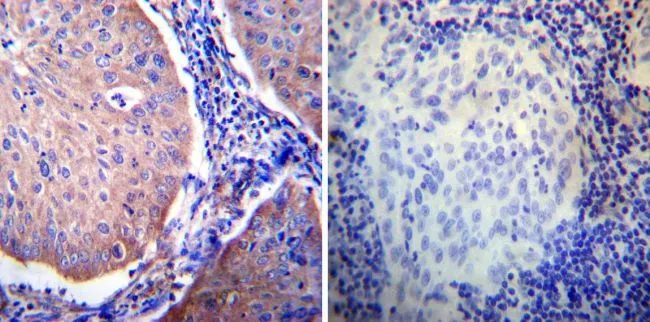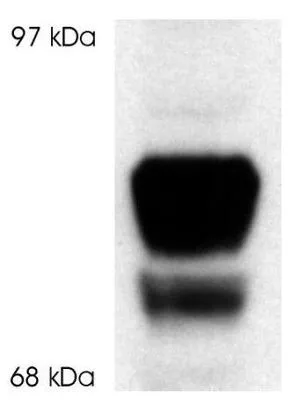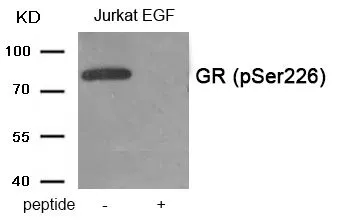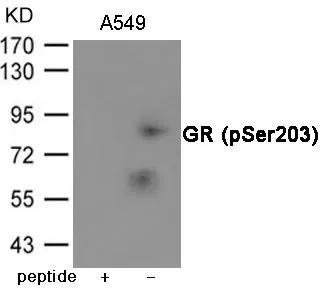Glucocorticoid Receptor antibody
GTX101120
ApplicationsImmunoFluorescence, ImmunoPrecipitation, Western Blot, ImmunoCytoChemistry, ImmunoHistoChemistry, ImmunoHistoChemistry Paraffin
Product group Antibodies
TargetNR3C1
Overview
- SupplierGeneTex
- Product NameGlucocorticoid Receptor antibody
- Delivery Days Customer9
- Application Supplier NoteWB: 1:500-1:3000. IHC-P: 1:100-1:1000. IP: 1:500-1:1000. *Optimal dilutions/concentrations should be determined by the researcher.Not tested in other applications.
- ApplicationsImmunoFluorescence, ImmunoPrecipitation, Western Blot, ImmunoCytoChemistry, ImmunoHistoChemistry, ImmunoHistoChemistry Paraffin
- CertificationResearch Use Only
- ClonalityPolyclonal
- Concentration1 mg/ml
- ConjugateUnconjugated
- Gene ID2908
- Target nameNR3C1
- Target descriptionnuclear receptor subfamily 3 group C member 1
- Target synonymsGCCR, GCR, GCRST, GR, GRL, glucocorticoid receptor, nuclear receptor subfamily 3 group C member 1 variant hGR-B(54), nuclear receptor subfamily 3 group C member 1 variant hGR-B(77), nuclear receptor subfamily 3 group C member 1 variant hGR-B(93), nuclear receptor subfamily 3, group C, member 1 (glucocorticoid receptor)
- HostRabbit
- IsotypeIgG
- Protein IDP04150
- Protein NameGlucocorticoid receptor
- Scientific DescriptionThe protein encoded by this gene is a receptor for glucocorticoids that can act as both a transcription factor and as a regulator of other transcription factors. This protein can also be found in heteromeric cytoplasmic complexes along with heat shock factors and immunophilins. The protein is typically found in the cytoplasm until it binds a ligand, which induces transport into the nucleus. Mutations in this gene are a cause of glucocorticoid resistance, or cortisol, resistance. Alternate splicing, the use of at least three different promoters, and alternate translation initiation sites result in several transcript variants encoding the same protein or different isoforms, but the full-length nature of some variants has not been determined. [provided by RefSeq]
- Storage Instruction-20°C or -80°C,2°C to 8°C
- UNSPSC12352203
References
- Kunke M, Knöfler H, Dahlke E, et al. Targeted deletion of von-Hippel-Lindau in the proximal tubule conditions the kidney against early diabetic kidney disease. Cell Death Dis. 2023,14(8):562. doi: 10.1038/s41419-023-06074-7Read this paper
- Butz H, Saskői É, Krokker L, et al. Context-Dependent Role of Glucocorticoid Receptor Alpha and Beta in Breast Cancer Cell Behaviour. Cells. 2023,12(5). doi: 10.3390/cells12050784Read this paper
- Yang HH, Su SH, Ho CH, et al. Glucocorticoid Receptor Maintains Vasopressin Responses in Kidney Collecting Duct Cells. Front Physiol. 2022,13:816959. doi: 10.3389/fphys.2022.816959Read this paper
- Ho CH, Yang HH, Su SH, et al. α-Actinin 4 Links Vasopressin Short-Term and Long-Term Regulation of Aquaporin-2 in Kidney Collecting Duct Cells. Front Physiol. 2021,12:725172. doi: 10.3389/fphys.2021.725172Read this paper
- Yi S, Shi W, Zuo M, et al. Endoplasmic Reticulum Stress Is Involved in Glucocorticoid-Induced Apoptosis in PC12 Cells. Anal Cell Pathol (Amst). 2021,2021:5565671. doi: 10.1155/2021/5565671Read this paper
- Sueyasu T, Morita S, Tokuda H, et al. Dietary arachidonic acid improves age-related excessive enhancement of the stress response. Eur Rev Med Pharmacol Sci. 2020,24(4):2110-2119. doi: 10.26355/eurrev_202002_20391Read this paper
- Matsuzaki K, Sugimoto N, Islam R, et al. Salivary Immunoglobulin A Secretion and Polymeric Ig Receptor Expression in the Submandibular Glands Are Enhanced in Heat-Acclimated Rats. Int J Mol Sci. 2020,21(3). doi: 10.3390/ijms21030815Read this paper
- Obradović MMS, Hamelin B, Manevski N, et al. Glucocorticoids promote breast cancer metastasis. Nature. 2019,567(7749):540-544. doi: 10.1038/s41586-019-1019-4Read this paper
- Kim SR, Song JH, Ahn JH, et al. Antiviral and anti-inflammatory activity of budesonide against human rhinovirus infection mediated via autophagy activation. Antiviral Res. 2018,151:87-96. doi: 10.1016/j.antiviral.2018.01.012Read this paper
- Wu YL, Chang JC, Lin WY, et al. Caffeic acid and resveratrol ameliorate cellular damage in cell and Drosophila models of spinocerebellar ataxia type 3 through upregulation of Nrf2 pathway. Free Radic Biol Med. 2018,115:309-317. doi: 10.1016/j.freeradbiomed.2017.12.011Read this paper






![ELISA analysis of antigen using GTX60389 Glucocorticoid Receptor antibody [6E6]. Red : Control antigen 100ng Purple : Antigen 10ng Green : Antigen 50ng Blue : Antigen 100ng](https://www.genetex.com/upload/website/prouct_img/normal/GTX60389/GTX60389_20170912_ELISA_w_23061123_618.webp)